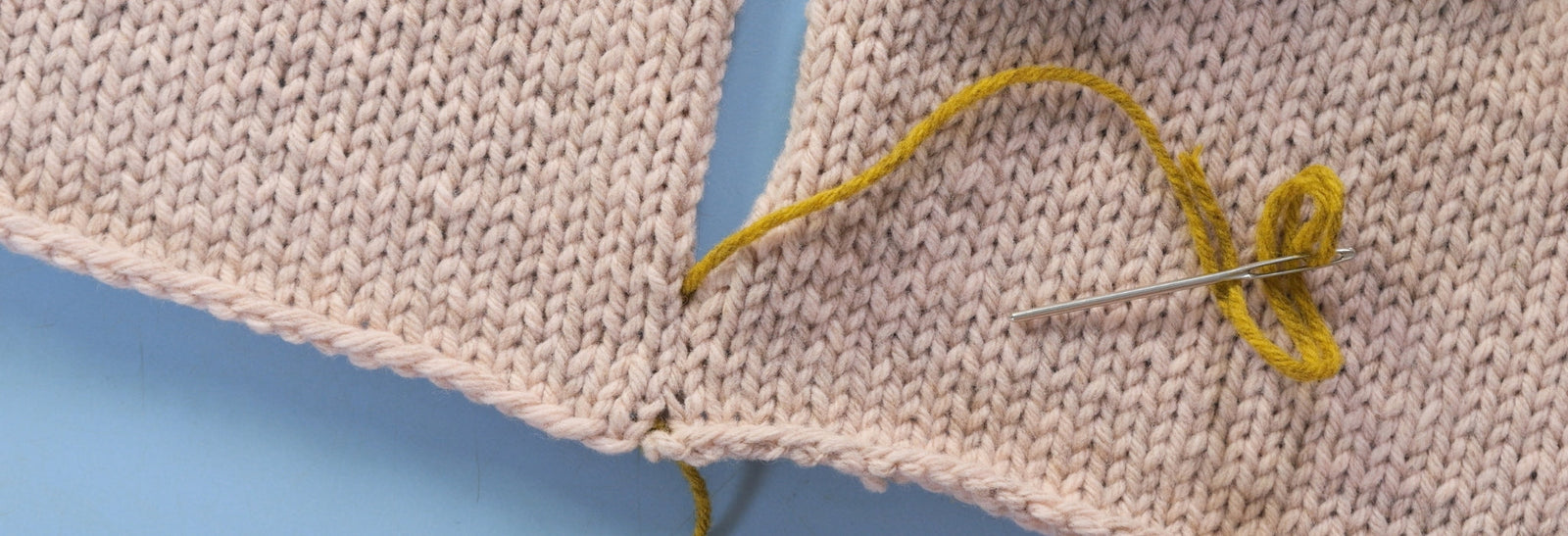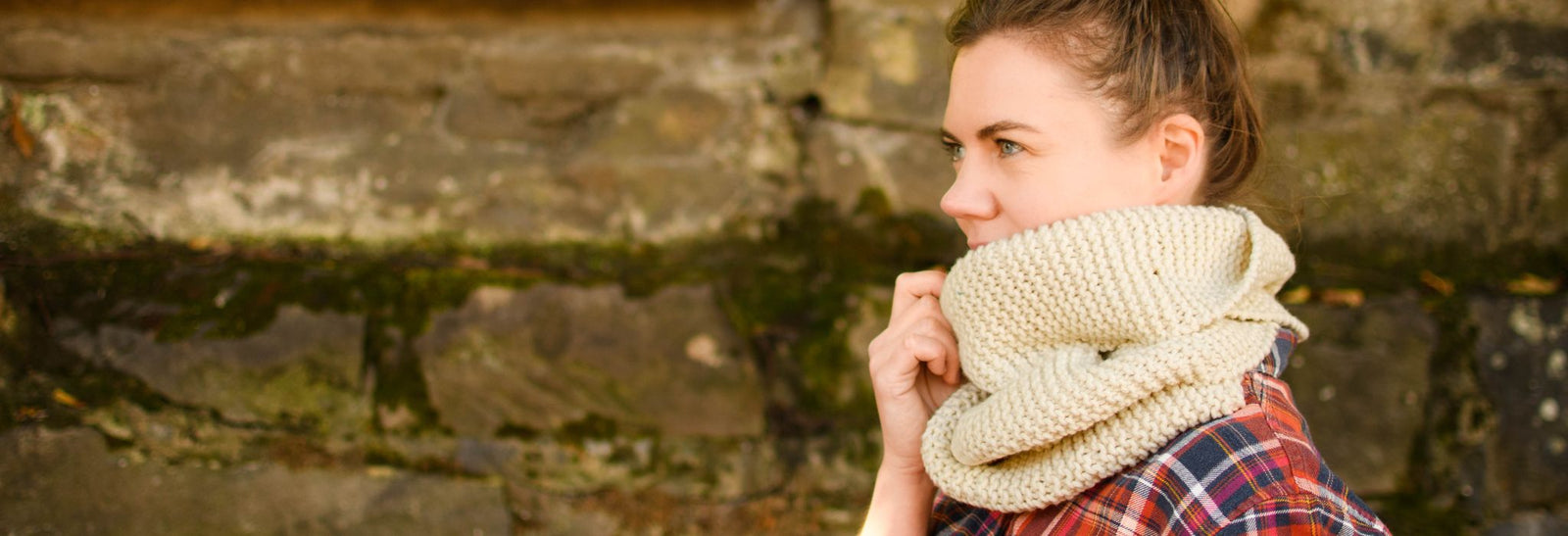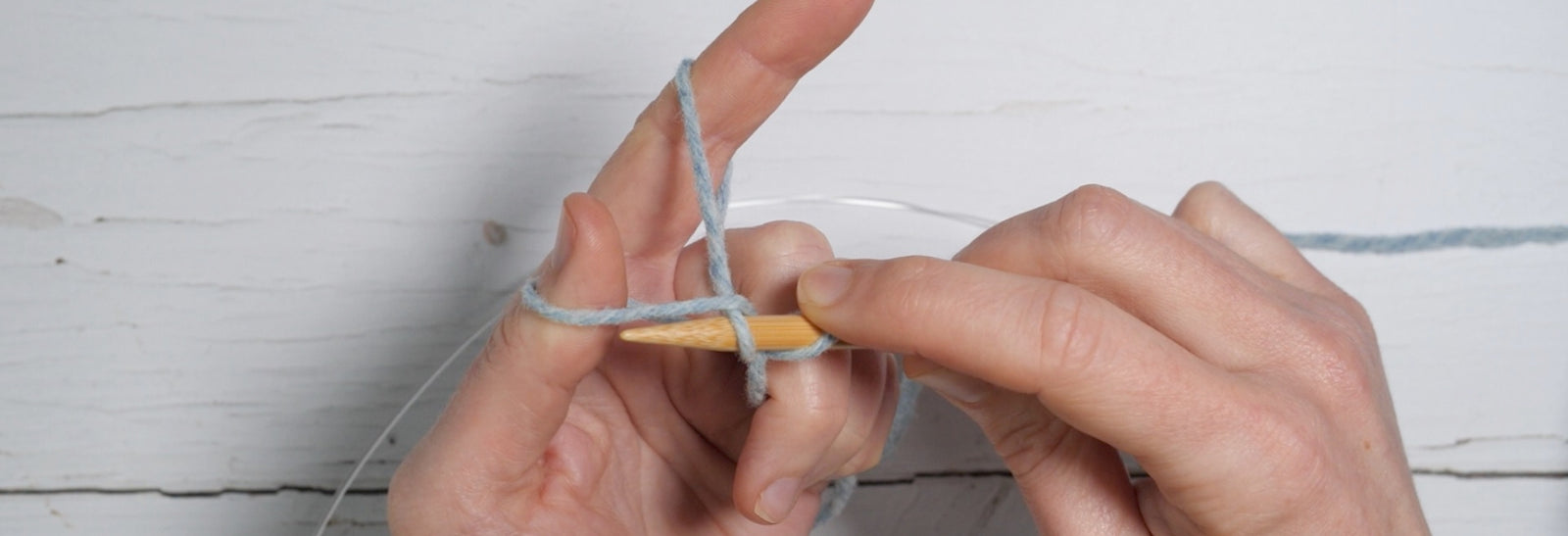Your Cart is Empty
Playing with colour palettes for Pyukkleen
November 10, 2014

Choosing colours for a stranded colourwork project like Pyukkleen is only the beginning. Once you’ve selected a palette you need to decide which colours should be used for the pattern and which for the background and how either or both should be shaded. Above is the palette I used for the cowl.
This single palette could be divided and shaded in a couple of different ways. Two colours are choosen for the smaller bands and the larger bands have both background and pattern colours shaded. Let’s focus on the larger bands. I think any pair of light and dark could be effective for the smaller bands and would dramatically change the overall effect of the cowl.
There are three things which can be used to, first, ensure contrast between pattern and background and, secondly, to control how the colours are shaded:
Warm — cool
Saturated — unsaturated
Dark — light


The palette split into cool and warm colours and shaded so the cool colours go from light to dark and the warmer hues go from dark to light. I’d be worried that the dramatic difference in darkness between the top colours and the rest of their groups would obscure the pattern. If I was going to use this division I’d probably change each of these colours to one with a similar tonal value as the others in their group. This would also increase the contrast between the two groups as one would now be cool and dark and the other would be lighter and warm. Depending on the pattern, however, keeping one of these as it is for a single central row might result in greater liveliness.


Here is the palette divided as shown in the pattern. Darker colours for the background on the left and lighter colours for the foreground on the right. Both are shaded by saturation or colour intensity so that the bottom, most saturated colours will be at the centre of the band.
Bex is making a version using brightly coloured leftover Nash Island Wool from her Jenny at the Fair. The varying amounts mean that she’s unable to use some of the colours as C1 and C2 (the colours used for the I-cord edgings and smaller pattern bands). She also only has 5 colours instead of the 6 shown in the pattern so she’ll use 3 for one of the groups and 2 for the other.



We also tried to divide these into cool and warm colours, but the pink and burgundy have too much contrast to work very well shaded.


Although the 2 colours on the right are almost at opposite sides of the colour wheel they have similar tonal values which contrast well with those on the right. In order to maintain contrast between these 2 groups one is shaded from warm to cool and the other from cool to warm — so that each row will have contrast in both hue and tonal value.

There wasn’t enough of the teal to use it as C1 so that left the burgundy (although you don’t have to stick with the rule that C1 is the first background colour on the wider bands!). Bex tried swatching it with the pink and blue as the background (there wasn’t enough of the pale green either). Although it doesn’t have as much contrast we both liked the pink more — you can see how much just changing this one colour would affect the overall impression of the cowl. One would read as mostly cool with pink elements and the other would be mostly pink and purple.
Also in Journal

Learn to Knit: Mattress Stitch
March 29, 2023
By following our step-by-step mattress stitch knitting tutorial, you'll learn how to make your seams look beautiful and how best to prepare your knitting so that when you seam it with mattress stitch, it goes smoothly on the first try.
Read More
How to Knit a Scarf: A Beginners Guide to Scarf Knitting
March 23, 2023
Want a quick and easy beginners tutorial on how to knit a scarf? This garter stitch scarf is easy to knit and requires just 3 skills; casting on, the knit stitch and casting off.
Read More
Learn to knit: the long tail cast-on
February 03, 2022
The long tail cast on is a great multi-purpose knitting cast on and the perfect place for beginner knitters to start. Learn how to work the long tail cast on and how to estimate the length of yarn needed with our clear step by step tutorial and video.
Read More Recent Articles
- Learn to Knit: Mattress Stitch March 29, 2023
- How to Knit a Scarf: A Beginners Guide to Scarf Knitting March 23, 2023
- Learn to knit: the long tail cast-on February 03, 2022
- How to Kitchener Stitch December 09, 2021
- Crochet Provisional Cast-on December 02, 2021
- Learn to knit: How to knit in the round with double pointed needles November 25, 2021
- Learn to knit: How to knit in the round using the magic loop technique November 25, 2021
- Learn to knit: How to knit in the round November 25, 2021
- Knitted Gift Ideas for you and your loved ones November 18, 2021
- Celebrating our Porty Hat Preview Knitters October 28, 2021
Free resources
-
KALS, step-by-step pattern guides and free patterns
Learn brioche with the free Daniel's Hat pattern
Tombreck - a free chevron beanie pattern
Working the brioche neck detail on the Polwarth sweater
Basics
Casting on
Decorative Channel Island Cast-on
Binding off
3 Easy Stretchy Bind-offs (p2tog bind-off; k2togtbl, k1 bind-off; Jeny's surprisingly stretchy bind-off)
Tubular Bind-off for brioche stitch
Increasing
Paired increase methods compared
Decreasing
Brioche stitch double decreases
Knitting in the round
How to Knit in the round using Magic Loop
How to Knit in the round using DPNs
Short rows
Swatching and gauge
Tips and tricks
Avoiding ears when binding off
Tighter purl stitches for neater cables and ribbing
Cabling without a cable needle
Reading knitting patterns
Understanding "continue in pattern"
Finishing
Garment knitting
Joining the body and sleeves on a seamless bottom up sweater
Sizing
Inclusive garment knitting
How to pick a garment without a model for you (specifically addresses finding garment patterns when your gender identity isn't represented and the styles you want to knit might not be sized to fit your body)
How does ease affect inclusive size ranges?
Specific stitch patterns
Lace
Identifying and fixing mistakes in lace knitting
Colourwork
Getting started with stranded colourwork
Understanding colour dominance
Working stranded colourwork over small circumferences
Decreases in stranded colourwork
Holding the yarn for stranded colourwork
Ladderback Jacquard (a neat way to deal with long floats)
Cables
Cabling without a cable needle
Cabling without a cable needle on the wrong side
How to knit cabled decreases
Closed ring cable increases and decreasesBrioche
How to work brioche stitch in the round
Other crafts
Cross stitch
How to begin your first large cross stitch project
How to finish a cross stitch project with an embroidery hoop frame
Mending

Sign up today
Find out the latest news from the studio such as sales, pattern releases, and new workshops or KALs our learning community, The Knitwork. We also share helpful tips and exclusive subscriber discounts...

